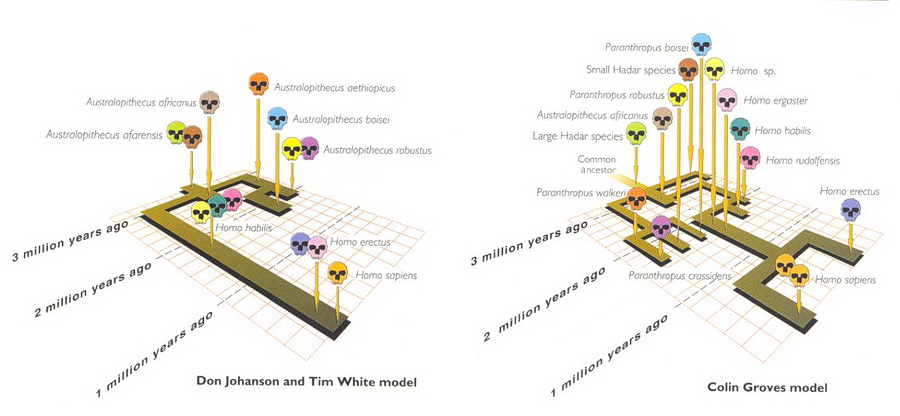The Fatal Flaw in a New Study to Show Human Evolution
This evolutionary story is
based largely on speculation
and belief, not evidence
by Jerry Bergman, PhD
The human brain is “often described as the most complex machine in the universe
due to its intricate structure, containing billions of neurons and trillions of connections,
enabling complex functions like thought, memory, and consciousness.”[1]
In an article titled “The Staggering Complexity of the Human Brain”[2] Damian Pang explained why “our brains are the most complex structures in the known universe.” First, the human brain contains close to 86 billion neuron cells, plus 85 billion other cells, and over 100 trillion connections. Researchers have spent several hundred million dollars on research in an effort to map the structure of the brain. So far they have failed.
The research ran for ten years and involved 500 scientists across different institutions.[3] There are another 85 billion cells that serve other functions in the brain, such as producing hormones. So far, almost 1,000 brain regions have been mapped. The goal was to map, and then simulate, the entire human brain to determine function. One reason for the failure is that the function of the brain is even more complex than its structure. How consciousness works is the greatest mystery. Even more incredible is that each one of these neurons connects to as many as thousands of other neurons, producing an additional estimated 100 trillion connections.[4] The computing power of the brain is one exaflop (one quintillion mathematical operations per second).
Attempting to Determine how the Brain Evolved
Although complete understanding of how the brain functions remains a mystery, evolutionists think they can understand how it evolved. One article confidently implied that their team of scientists could explain it.[5] The article title asked, “How did the large brain evolve? New insights into the development [evolution] of the human brain” [6] This new study, the authors claim, has helped to understand brain development but, as we will explain, their theory goes far beyond the evidence that the study invoked.[7]
What the neuroscientist’s research found was that two specific genes, existing only in humans, influence the development of the cerebrum.[8] These few genes are two of many that create the enormous difference in human brains compared to that of all other animals. Scientists have known that human brains are very different from all animals’ brains for eons. They know of at least two specific genes that help to explain this difference. They also now know why these two genes are important and what they do:
The results of the study show that the two genes act in a finely tuned interplay: one ensures that the progenitor cells of the brain multiply more, while the other causes these cells to transform into a different type of progenitor cell — the cells that later form the nerve cells of the brain.[9]
Creationists accept this finding at face value because it helps to scientifically explain the chasm existing between humans and all other life. Evolutionists go beyond these facts and try to explain it by saying this: During
the course of evolution, this interplay has led to the human brain being unique in its size and complexity. The newly gained insights not only provide a deeper understanding of the evolutionary development of our brain …’Our findings deepen the fundamental understanding of brain development and provide new insights into the evolutionary origins of our large brain.’[10].
Major Problems With the Study
The most obvious problem with the study was that the researchers did not compare a modern human brain with a two-million-year-old or older mammal. Such a comparison is impossible, of course. Instead, they compared a modern human with a modern mouse and assumed that the mouse represents our ancient common ancestor, the progenitor of rats and humans.
This lack of evidence of human evolutionary ancestors has always been a major problem in proving human evolution. They do have bone fragments which they claim are evidence of human evolution. The fact that this evidence is difficult to interpret is why enormous debate exists on the correct human evolutionary phylogeny as illustrated in the four phylogeny comparisons in figure 1 and 2.

Figure 1: From People of the Past. The Epic Story of Human Origins. San Francisco, CA. Fog City Press. Edited by Göran Burenhult. 2003 pp. 50-51

Figure 2: Today’s anthropologists know that the picture is far from progressive, but scattered and confusing. From People of the Past. The Epic Story of Human Origins. San Francisco, CA. Fog City Press. Edited by Göran Burenhult. 2003 pp. 50-51
Summary
The claim that “Two specific genes found exclusively in humans jointly influence the development of the cerebrum” was supported by the empirical evidence, but the claim that “researchers have provided evidence that these genes contribute … to the evolutionary enlargement of the brain” has not been experimentally confirmed. For this reason, this evolutionary conclusion was based largely on speculation and belief, not evidence. One main reason it cannot be scientifically supported is because no preserved brains exist of pre-humans living when humans allegedly were diverging from our common ancestor. Therefore, belief is required to fill in this gap.
References
[1] https://www.google.com/search?q=human+brain+is+often+described+as+the+most+complex+machine+in+the+Universe.
[2] Pang, Damian. 2023. The Staggering Complexity of the Human Brain. Why our brains are the most complex structures in the known universe. Psychology Today. https://www.psychologytoday.com/us/blog/consciousness-and-beyond/202309/the-staggering-complexity-of-the-human-brain.
[3] Naddaf, M. 2023. Europe spent €600 million to recreate the human brain in a computer. How did it go? Nature, 620(7975), 718-720. https://www.nature.com/articles/d41586-023-02600-x
[4] This section was from Psychology Today. https://www.psychologytoday.com/us/blog/consciousness-and-beyond/202309/the-staggering-complexity-of-the-human-brain
[5] March 26, 2025. How did the large brain evolve? New insights into the development of the human brain. German Primate Center, https://www.dpz.eu/en/public-engagement/news/article/wie-ist-das-grosse-gehirn-entstanden
[6] German Primate Center.
[7] Nesil Eşiyok, et al. 2025.. A dyad of human-specific NBPF14 and NOTCH2NLB orchestrates cortical progenitor abundance crucial for human neocortex expansion. Science Advances, 2025; 11 (13) DOI: 10.1126/sciadv.ads7543
[8] Nesil Eşiyok, et al. 2025
[9] German Primate Center.
[10] German Primate Center.
 Dr. Jerry Bergman has taught biology, genetics, chemistry, biochemistry, anthropology, geology, and microbiology for over 40 years at several colleges and universities including Bowling Green State University, Medical College of Ohio where he was a research associate in experimental pathology, and The University of Toledo. He is a graduate of the Medical College of Ohio, Wayne State University in Detroit, the University of Toledo, and Bowling Green State University. He has over 1,900 publications in 14 languages and 40 books and monographs. His books and textbooks that include chapters that he authored are in over 1,800 college libraries in 27 countries. So far over 80,000 copies of the 60 books and monographs that he has authored or co-authored are in print. For more articles by Dr Bergman, see his Author Profile.
Dr. Jerry Bergman has taught biology, genetics, chemistry, biochemistry, anthropology, geology, and microbiology for over 40 years at several colleges and universities including Bowling Green State University, Medical College of Ohio where he was a research associate in experimental pathology, and The University of Toledo. He is a graduate of the Medical College of Ohio, Wayne State University in Detroit, the University of Toledo, and Bowling Green State University. He has over 1,900 publications in 14 languages and 40 books and monographs. His books and textbooks that include chapters that he authored are in over 1,800 college libraries in 27 countries. So far over 80,000 copies of the 60 books and monographs that he has authored or co-authored are in print. For more articles by Dr Bergman, see his Author Profile.




Comments
Another example of how we must separate observation from giddy origin story telling.
Thank you JSwan. I am glad that I am not the only person who separates observation from mere story telling or opinion. Everything about evolution is backwards to the biblical account. In evolution, planets come before the earth. Dinosaurs come before birds. Africa is the first. In the biblical account, earth is created before the planets. Birds are created before dinosaurs. The Middle East is the first.